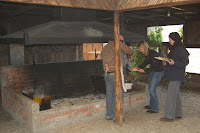
The last day of the trip (not including travel days)! Another long drive from Torres del Paine to Puerto Natales, then to Punta Arenas for the flight back to Santiago. Images flash.... In the bus, Juanito (the drive), TC (trip leader) and Sergio (local guide) are passing around the mate cup. Outside, a beret-wearing gaucho chases down and ropes an errant calf. Non-native alfalfa being bailed for a long winter. Granite spires and snow-covered peaks of the Patagonian ice-field.
We reached Puerto Natales mid-morning in time for a coffee and hot chocolate refreshment. The town reminds me much of Kodiak Island, Alaska; quiet and charming.

Almost to Punta Arenas, we stopped at an estancia for an asado (traditional barbeque). The food was fine, but I wasn't thrilled that the owner had turned his property into a kind of zoo to show tourists, keeping otherwise wild animals and birds in cages. They also gave us a sheep-shearing demonstration, which I could have done without. Watching a terrified sheep lose its coat has no appeal!

In Patagonia, ranchers have have been raising sheep for the last 100 years. Now, their big market is China. But sheep hooves are very damaging to the soil, making it harder for the wild animals to survive. In contrast, the native guanacos have soft padded feet that tread lightly...
Outside Puerto Natales for the first time I saw plastic bag pollution, with hundreds of plastic bags caught in stunted deciduous beech trees. Until then, I had seen not a one plastic bag littering the landscape. I noticed that no one gave plastic bags - even when I asked for one to cover a book I would be putting in my suitcase. Didn't have them. I asked about the pollution issue, but no one seemed to know. I think they realized a long time ago that wind and plastic bags don't mix.





































